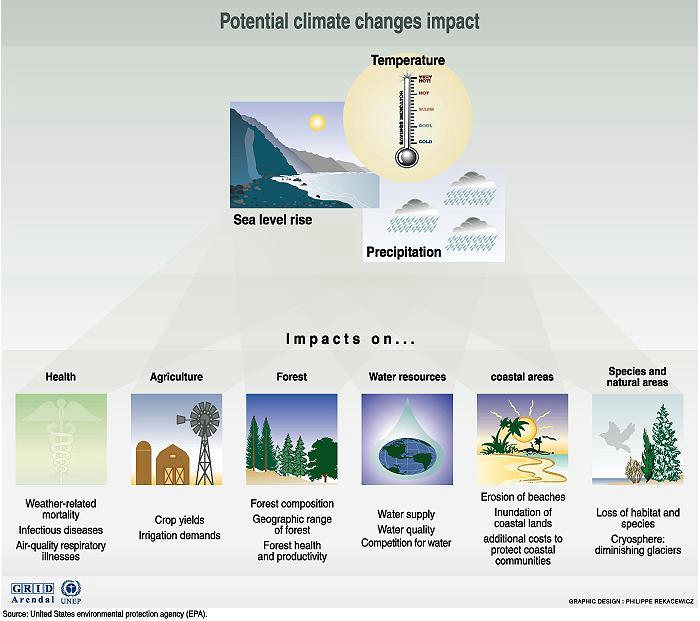
 |

Humanity's greenhouse gas emissions are expected to lead to climatic changes in the 21st century and beyond. These changes will potentially have wide-ranging effects on the natural environment as well as on human societies and economies. Scientists have made estimates of the potential direct impacts on various socio-economic sectors, but in reality the full consequences would be more complicated because impacts on one sector can also affect other sectors indirectly. To assess potential impacts, it is necessary to estimate the extent and magnitude of climate change, especially at the national and local levels. Although much progress has been made in understanding the climate system and climate change, projections of climate change and its impacts still contain many uncertainties, particularly at the regional and local levels. (reference)
| The
six IPCC scenarios The projection of future climate change depends partly on the assumptions made about future emissions of greenhouse gases and aerosol precursors and the proportion of emissions remaining in the atmosphere. |
|
| Projected
changes in CO2 and climate: summary of assumptions
in the IPCC 1992 alternative scenarios Projected anthropogenic CO2 emissions from fossil fuel use, deforestation and cement production for the six IPCC emission scenarios. |
|
| Projected
Changes in Global Temperature Climate models calculate that the global mean surface temperature could rise by about 1 to 4.5 centigrade by 2100. |
|
| Scenarios
of sea level rise Models project an increase in global mean sea level of between 13 and 94 cm by the year 2100. |
|
| Sensitivity,
Adaptability and Vulnerability The potential impacts of climate change on the environment and socio-economic systems can be understood in terms of sensitivity, adaptability and vulnerability of the system. |
|
| The
great weather and flood catastrophes over the last forty years
Some reports suggest that increase in climate variability or extremes has taken place in recent decades. |
 |
Forest
composition case study in North America ... |
|
|
Impact
on mountain vegetation zones The figure shows a comparison of current vegetation zones at a hypothetical dry temperate mountain site with simulated vegetation zones under a climate-warming scenario. |
|
|
Thinning
of the Arctic sea-ice Ice draft in the 1990s is more than a meter thinner than it was 20 to 40 years earlier. |
|
|
Evolution
of the ice-breaking date in the River Torino (Finland) Winter ice on the Tornio River in Finland has broken up earlier and earlier since records began in 1693. |
 |
Changes
in permafrost temperatures at various depths in Fairbanks (Alaska) Widespread loss of discontinous permafrost will trigger erosion or subsidence of ice-rich landscapes, change hydrologic processes, and release CO2 and methane to the atmosphere. |
 |
Great
ocean conveyor belt The global conveyor belt thermohaline circulation is driven primarily by the formation and sinking of deep water (from around 1500m to the Antarctic bottom water overlying the bottom of the ocean) in the Norwegian Sea. |
 |
Potential
impact of sea-level rise on Bangladesh Bangladesh, one of the world's poorest nations is also the country most vulnerable to sea-level rise. |
 |
Potential
impact of sea level rise: Nile Delta (today) The Nile Delta is one of the oldest intensely cultivated areas on earth. It is very heavily populated, with population densities up to 1600 inhabitants per square kilometer. The low lying, fertile floodplains are surrounded by deserts. Only 2,5% of Egypt's land area, the Nile delta and the Nile valley, is suitable for intensive agriculture. Most of a 50 km wide land strip along the coast is less than 2 m above sea-level and is protected from flooding by a 1 to 10 km wide coastal sand belt only, shaped by discharge of the Rosetta and Damietta branches of the Nile. Erosion of the protective sand belt is a serious problem and has accelerated since the construction of the Aswan dam. |
 |
Potential
impact of sea level rise: Nile Delta (0.5 to 1.0 metres) Rising sea level would destroy weak parts of the sand belt, which is essential for the protection of lagoons and the low-lying reclaimed lands. The impacts would be very serious: One third of Egypt's fish catches are made in the lagoons. Sea level rise would change the water quality and affect most fresh water fish. Valuable agricultural land would be innundated. |
 |
Changes
on cereal production under three different GCM equilibrium scenarios The figure shows change in cereals production under three different GCM equilibrium scenarios (percent from base estimated in 2060). |
 |
Impact
of temperature rise on robusta coffee in Uganda In Uganda, the total area suitable for growing Robusta coffee would be dramatically reduced with a temperature increase of 2 centigrades. |
|
|
Freshwater
stress Even if the world maintained the pace of the 1990s in water supply development, it would not be enough to ensure that everyone had access to safe drinkning water by 2025. |
|
|
Population
and freshwater stress One study suggests that although global water conditions may worsen by 2025 due to population pressure, climate change could have a net positive impact on global water resources. |
 |
Spread
of major tropical vector-borne diseases Climate change and altered weather patters would affect the range (both altitude and latitude), intensity, and seasonality of many vector-borne and other infectioius diseases. |
 |
Potential
dengue transmission in case of temperature rise A warmer climate increases occasions of vector borne tropical diseases. The figure depicts weeks of potential dengue transmission under current temperature and 2°C and 4 °C warming. |
|
|
Malaria.
Plasmodium vivax, with the Anopheles mosquito as a vector, is an organism causing malaria. The main climate factors that have bearing on the malarial transmission potential of the mosquito population are temperature and precipitation. |
You want to share some ideas, or data with the visitors of the Corrosion Doctors Web siteplease send a note to our